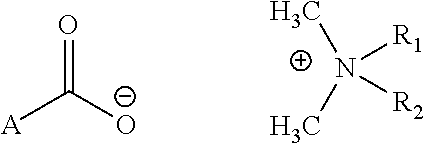Topical antimicrobial compositions
a technology of compositions and antimicrobial agents, applied in the field oftopical antimicrobial compositions, can solve the problems of limited activity, fire hazards, and ineffective antibacterial and fungal spores, and achieve the effects of not being effective against bacteria and fungal spores
- Summary
- Abstract
- Description
- Claims
- Application Information
AI Technical Summary
Problems solved by technology
Method used
Image
Examples
example 1
Preparation of N,N-di-n-decyl-N,N-dimethyl-ammonium 5-oxopyrrolidine-2-carboxylate (DAPC)
[0025]1. Dissolve 0.03 mol NaOH in deionized water, make the total weight 30 g and cool it to room temperature.[0026]2. Dissolve D-Pyroglutamic acid (2-Pyrrolidone-5-carboxylic acid) 0.03 mol in the above solution containing 30 g NaOH, stirring for 10 min. the reaction product is an aqueous solution of Sodium D-Pyroglutamic acid (solution A).[0027]3. Dissolve 0.025 mol N,N-di-n-decyl, N-didimethylammonium chloride in 160 g deionized water, (solution B).[0028]4. mix solution A and solution B to obtain solution C.[0029]5. Transfer solution C to an extraction flask, add 400 ml organic solvent and 10 gram sodium chloride to the flask, mix well and let it stand for 30 min to separate in two layers.[0030]6. The organic solvent is separated from the aqueous layer and is evaporated by a Rota vapor to obtain product DAPC.[0031]7. The aqueous portion is mixed with pure organic solvent to extract more orga...
example 2
Preparation of N,N-di-n-decyl-N,N-dimethyl-ammonium N-acetylatedal alanine carboxylate (DAAC)
[0033]1. Dissolve 0.03 mol NaOH in deionized water, make the total weight 30 g and cool it to room temperature.[0034]2. Dissolve acetylated alanine acid (2-Pyrrolidone-5-carboxylic acid) 0.03 mol in the above solution containing 30 g NaOH, stirring for 10 min. The reaction product is an aqueous solution of Sodium acetylated alanine acid (solution A).[0035]3. Dissolve 0.025 mol N,N-di-n-decyl, N-didimethylammonium chloride in 160 g deionized water, (solution B).[0036]4. mix solution A and solution B to obtain solution C.[0037]5. Transfer solution C to an extraction flask, add 400 ml organic solvent and 10 gram sodium chloride to the flask, mix well and let it stand for 30 min to separate in two layers.[0038]6. The organic solvent is separated from the aqueous layer and is evaporated by a Rota vapor to obtain product DAPC.[0039]7. The aqueous portion is mixed with pure organic solvent to extra...
example 3
[0041]Other examples can be prepared accordingly, including:
[0042]
PUM
| Property | Measurement | Unit |
|---|---|---|
| temperature | aaaaa | aaaaa |
| temperature | aaaaa | aaaaa |
| corrosive | aaaaa | aaaaa |
Abstract
Description
Claims
Application Information
 Login to View More
Login to View More - R&D
- Intellectual Property
- Life Sciences
- Materials
- Tech Scout
- Unparalleled Data Quality
- Higher Quality Content
- 60% Fewer Hallucinations
Browse by: Latest US Patents, China's latest patents, Technical Efficacy Thesaurus, Application Domain, Technology Topic, Popular Technical Reports.
© 2025 PatSnap. All rights reserved.Legal|Privacy policy|Modern Slavery Act Transparency Statement|Sitemap|About US| Contact US: help@patsnap.com



